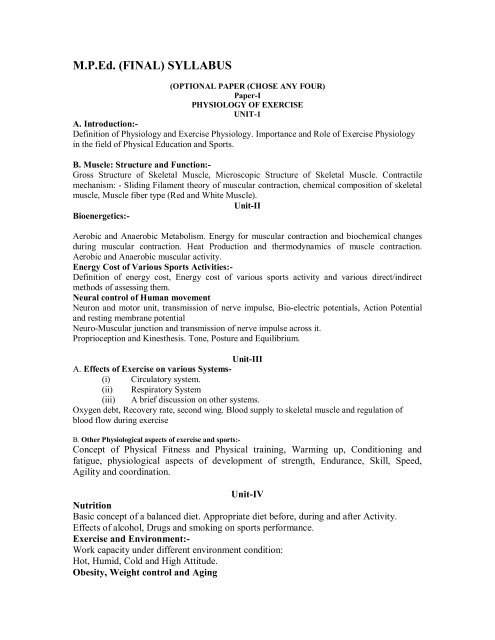Department of Physical Education - Mahatma Gandhi Kashi ...
Department of Physical Education - Mahatma Gandhi Kashi ... Department of Physical Education - Mahatma Gandhi Kashi ...
M.P.Ed. (FINAL) SYLLABUS(OPTIONAL PAPER (CHOSE ANY FOUR)Paper-IPHYSIOLOGY OF EXERCISEUNIT-1A. Introduction:-Definition of Physiology and Exercise Physiology. Importance and Role of Exercise Physiologyin the field of Physical Education and Sports.B. Muscle: Structure and Function:-Gross Structure of Skeletal Muscle, Microscopic Structure of Skeletal Muscle. Contractilemechanism: - Sliding Filament theory of muscular contraction, chemical composition of skeletalmuscle, Muscle fiber type (Red and White Muscle).Unit-IIBioenergetics:-Aerobic and Anaerobic Metabolism. Energy for muscular contraction and biochemical changesduring muscular contraction. Heat Production and thermodynamics of muscle contraction.Aerobic and Anaerobic muscular activity.Energy Cost of Various Sports Activities:-Definition of energy cost, Energy cost of various sports activity and various direct/indirectmethods of assessing them.Neural control of Human movementNeuron and motor unit, transmission of nerve impulse, Bio-electric potentials, Action Potentialand resting membrane potentialNeuro-Muscular junction and transmission of nerve impulse across it.Proprioception and Kinesthesis. Tone, Posture and Equilibrium.Unit-IIIA. Effects of Exercise on various Systems-(i) Circulatory system.(ii) Respiratory System(iii) A brief discussion on other systems.Oxygen debt, Recovery rate, second wing. Blood supply to skeletal muscle and regulation ofblood flow during exerciseB. Other Physiological aspects of exercise and sports:-Concept of Physical Fitness and Physical training, Warming up, Conditioning andfatigue, physiological aspects of development of strength, Endurance, Skill, Speed,Agility and coordination.Unit-IVNutritionBasic concept of a balanced diet. Appropriate diet before, during and after Activity.Effects of alcohol, Drugs and smoking on sports performance.Exercise and Environment:-Work capacity under different environment condition:Hot, Humid, Cold and High Attitude.Obesity, Weight control and Aging
M.P.Ed. (FINAL)Paper-IISPORTS PHYCHOLOGYUNTY-1A. Meaning, Nature and scope of sports Psychology, Development of sports psychology. Relationshipof sports psychology with other sport sciences. Importance of Sports psychology in Physicaleducation and coaches.UNTY-2Cognitive process in physical activities:-Meaning of cognition, Characteristics of cognitive process in sports, Role of sensation and perception,Thinking, Imagination and Memory in physical activities .Mental activity of athletics, mental activity and sports related goals. Meanings of attention, Dimensions ofattention, strategies to develop attention.Motor Learning:-Meaning of motor learning, Factors affecting motor development in various periods of childhood andadolescence.Action regulation:-Meaning of action regulation, Important Psychological characteristics of physical activities, structure ofaction programme, action programme in different games and sports.UNTY-3Personality:-Meaning of personality, Traits of sportsperson, Relationship of personality to sports performance,personality differences among various sports.Motivation:-Meaning of motive, Need, Drive, Role of motives, Attitudes and interest in physical activities.Meaning of motivation, Techniques of motivation, Types of motivation, Relationship between extrinsic andintrinsic motivation.Emotion:-Meaning and types of emotion, Influence of Emotion (success and failure) On Level of aspiration,achievement, Anxiety, Fear, Frustration, Conflict and its effect on sports performance.UNTY-4Psychology aspect of competition:-Definition of competitions, Determinants of competitive behaviour,psychological characteristics of pre-competition, competition and post competition, selected psychoregulative techniques for relaxation and activation.Psychological aspects of long term and short term preparation for competition psychological care ofinjuries prevention and coping techniques.Social Facilitation:- Presence of others, coaction effect and audience effect in sports Factors mediatingsocial facilitation’s. Methods of investigation in sports psychology:Various methods used in sports psychology, Different tests in sports psychology.
- Page 1 and 2: Department of Physical Education(B.
- Page 3 and 4: “kkjhfjd f”k{kk esa laxBu]iz”
- Page 5 and 6: dk;Zogu ,oa izf”k{k.k ds fl)kUr¼
- Page 7 and 8: xfrcy foKku] LokLF; f”k{kk ,oa [k
- Page 9 and 10: euksjatu] f”kfoj rFkk “kkjhfjd
- Page 11 and 12: MANAGEMENT OF PHYSICAL EDUCATION AN
- Page 13 and 14: UNIT-4A. Planning and Organisation
- Page 15: UNIT-4(i) Measurement of sports ski
- Page 19 and 20: M.P.Ed. (FINAL)Paper - IVSPORTS BIO
- Page 21 and 22: M.P.Ed. (FINAL)Paper -VISPORTS MEDI
M.P.Ed. (FINAL) SYLLABUS(OPTIONAL PAPER (CHOSE ANY FOUR)Paper-IPHYSIOLOGY OF EXERCISEUNIT-1A. Introduction:-Definition <strong>of</strong> Physiology and Exercise Physiology. Importance and Role <strong>of</strong> Exercise Physiologyin the field <strong>of</strong> <strong>Physical</strong> <strong>Education</strong> and Sports.B. Muscle: Structure and Function:-Gross Structure <strong>of</strong> Skeletal Muscle, Microscopic Structure <strong>of</strong> Skeletal Muscle. Contractilemechanism: - Sliding Filament theory <strong>of</strong> muscular contraction, chemical composition <strong>of</strong> skeletalmuscle, Muscle fiber type (Red and White Muscle).Unit-IIBioenergetics:-Aerobic and Anaerobic Metabolism. Energy for muscular contraction and biochemical changesduring muscular contraction. Heat Production and thermodynamics <strong>of</strong> muscle contraction.Aerobic and Anaerobic muscular activity.Energy Cost <strong>of</strong> Various Sports Activities:-Definition <strong>of</strong> energy cost, Energy cost <strong>of</strong> various sports activity and various direct/indirectmethods <strong>of</strong> assessing them.Neural control <strong>of</strong> Human movementNeuron and motor unit, transmission <strong>of</strong> nerve impulse, Bio-electric potentials, Action Potentialand resting membrane potentialNeuro-Muscular junction and transmission <strong>of</strong> nerve impulse across it.Proprioception and Kinesthesis. Tone, Posture and Equilibrium.Unit-IIIA. Effects <strong>of</strong> Exercise on various Systems-(i) Circulatory system.(ii) Respiratory System(iii) A brief discussion on other systems.Oxygen debt, Recovery rate, second wing. Blood supply to skeletal muscle and regulation <strong>of</strong>blood flow during exerciseB. Other Physiological aspects <strong>of</strong> exercise and sports:-Concept <strong>of</strong> <strong>Physical</strong> Fitness and <strong>Physical</strong> training, Warming up, Conditioning andfatigue, physiological aspects <strong>of</strong> development <strong>of</strong> strength, Endurance, Skill, Speed,Agility and coordination.Unit-IVNutritionBasic concept <strong>of</strong> a balanced diet. Appropriate diet before, during and after Activity.Effects <strong>of</strong> alcohol, Drugs and smoking on sports performance.Exercise and Environment:-Work capacity under different environment condition:Hot, Humid, Cold and High Attitude.Obesity, Weight control and Aging



